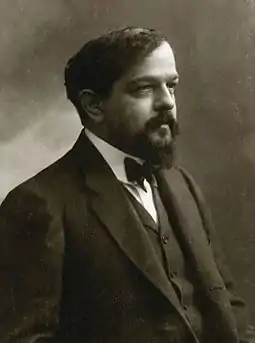Images pour orchestre
Images pour orchestre, L. 122, is an orchestral composition in three sections by Claude Debussy, written between 1905 and 1912. Debussy had originally intended this set of Images as a two-piano sequel to the first set of Images for solo piano, as described in a letter to his publisher Durand as of September 1905. However, by March 1906, in another letter to Durand, he had begun to think of arranging the work for orchestra rather than two pianos.[1]
| Images pour orchestre | |
|---|---|
| Orchestral music by Claude Debussy | |
 The composer in 1908, photo by Félix Nadar | |
| English | Images for Orchestra |
| Catalogue | L. 122 |
| Composed | 1905–12 |
| Movements | three sections, five movements |
Scoring
Images pour orchestre is scored for a large orchestra consisting of 2 piccolos, 2 flutes, 2 oboes, oboe d'amour, cor anglais, 3 clarinets,
bass clarinet, 3 bassoons, contrabassoon, 4 horns and 4 trumpets (in C), 3 trombones, tuba, timpani, field drum, tambourine, castanets, 2 harps, celesta, triangle, xylophone, cymbals, 3 bells, strings.
Sections
I. Gigues (1909–1912)
The original title of Gigues was Gigues tristes. Debussy used his memories of England as inspiration for the music, in addition to the song "Dansons la gigue" by Charles Bordes[2] and the Tyneside folk tune "The Keel Row",[3] which are used as key themes.
Revolving around Gigues are musical cells which give a sense of unity to the piece. Most are short motifs which appear once or twice or are reused in fragments throughout the piece. Other themes are long solo passages written particularly for the oboe d'amour.
Controversy exists over the role of André Caplet in the orchestration of Gigues. Robert Orledge and Williametta Spencer are two writers, for example, who have accepted Caplet as assisting with the orchestration.[2][4] In contrast, François Lesure has stated, based on manuscript examination in the Bibliothèque nationale (MS 1010), that Caplet did not assist with the orchestration.[5]
II. Ibéria (1905–1908)
Ibéria is the most popular of the three orchestral Images and itself forms a triptych within the triptych. Its sections are:
- Par les rues et par les chemins (Along the streets and along the paths)
- Les parfums de la nuit (The scents of the night)
- Le matin d'un jour de fête (The morning of a festive day) - a procession of a 'banda de guitarras'
Impressions of Spain inspired this music. Richard Langham Smith has commented on Debussy's own wish to incorporate ideas of juxtaposing elements of the visual arts in musical terms,[6] including a quote from Debussy to Caplet from a letter of 26 February 1910:
You can't imagine how naturally the transition works between 'Parfums de la nuit' and 'Le Matin d'un jour de fête. Ça n'a pas l'air d'être écrit.[7]
Matthew Brown has briefly commented on Debussy's use of techniques such as incomplete progressions, parenthetical episodes and interpolations in Ibéria.[8]
III. Rondes de printemps ("Round dances of spring") (1905–1909)
This is one of Debussy's most modern works. He used two folk tunes, "Nous n'irons plus au bois" and "Do, do l'enfant do" in this movement.[8] Brown, Dempster and Headlam have analyzed the tonal structure of this movement.[9] The first song plays a prominent role from the start of the 15
8 time until the end of the movement, in the solos and in the accompaniments and countermelodies.
Debussy had already quoted the song Nous n'irons plus au bois in Images oubliées of 1894 for piano and in Jardins sous la pluie from Estampes (1903).
References
- Orledge, Robert (1974). "Debussy's Musical Gifts to Emma Bardac". The Musical Quarterly. LX (4): 544–556. doi:10.1093/mq/LX.4.544. Retrieved 2008-02-23.
- Spencer, Williametta (1980). "The Relationship between André Caplet and Claude Debussy". The Musical Quarterly. LXVI (1): 112–131. doi:10.1093/mq/LXVI.1.112. Retrieved 2008-02-23.
- Pirie, Peter J. (1967). "Portrait of Debussy. 5: Debussy and English Music". The Musical Times. 108 (1493): 599–601. doi:10.2307/953799. JSTOR 953799.
- Orledge, Robert (1974). "Debussy's Orchestral Collaborations, 1911–13. 1: Le martyre de Saint-Sébastien". The Musical Times. The Musical Times, Vol. 115, No. 1582. 115 (1582): 1030–1035. doi:10.2307/960380. JSTOR 960380.
- Orledge, Robert (1996). "Reviews of Books: Claude Debussy: biographie critique by François Lesure". Music & Letters. 77 (1): 132–133. JSTOR 737556.
- Richard Langham Smith, "Debussy and the Art of the Cinema" (January 1973). Music & Letters, 54 (1): pp. 61–70.
- Paul Driver, "Debussy through His Letters" (December 1987). The Musical Times, 128 (1738): pp. 687–689.
- Brown, Matthew (Autumn 1993). "Tonality and Form in Debussy's Prélude à 'L'Après-midi d'un faune". Music Theory Spectrum. 15 (2): 127–143. doi:10.1525/mts.1993.15.2.02a00010. JSTOR 745811.
- Brown, Matthew; Dempster, Douglas; and Headlam, Dave; Dempster, Douglas; Headlam, Dave (Autumn 1997). "The ♯IV(♭V) Hypothesis: Testing the Limits of Schenker's Theory of Tonality". Music Theory Spectrum. 19 (2): 155–183. doi:10.1525/mts.1997.19.2.02a00020. JSTOR 745752.
External links
- Images pour Orchestre: Scores at the International Music Score Library Project
- "Claude Achille Debussy – Iberia: Images for Orchestra, No. 2", Unknown author, 1935 article